How to verify the authenticity of a black diamond pendant?
Key Takeaway:
- Before committing to buying a diamond, it’s important to verify if it is genuine. Seek advice from a reputable jeweler if you are unsure.
- There are many diamond imitations that can deceive buyers, such as white topaz, white sapphire, and white zircon. Therefore, it’s essential to understand the differences between mounted and loose diamonds and to do your homework first.
- Black diamonds are rare and have unique beauty. They can be found in select locations such as Brazil and the Central African Republic. There are natural, treated white diamond, and lab-grown diamond black diamonds. Additionally, imperfections can be used to identify genuine ones.
- Simple tests such as the fog test can help determine if a diamond is real or fake, but no at-home test should be considered conclusive. A diamond expert with proper equipment and experience is essential to confirming authenticity.
Understanding the Importance of Verifying the Authenticity of a Black Diamond Pendant

Photo Credits: Www.Blackdiamondpendant.Com by Juan Miller
A genuine black diamond pendant can be costly, but how do you ascertain its authenticity? Verifying the authenticity of a black diamond is significant. It can help you avoid scams and ensure that you get the value for your investment.
Importance of verifying diamond authenticity
Are you looking for a black diamond pendant? It’s key to check its authenticity first. Knowing if it’s real or not determines its quality and worth.
You must know the difference between natural, treated white, and lab-grown diamonds. Real black diamonds are rare, but lab-grown ones look similar but are cheaper.
To identify a genuine black diamond, look for its deep black color and opaque appearance – no transparency or sparkle. Inclusions and flaws like cracks and cleavages in a mined stone mean it is real. Scratches on a real black diamond appear as tiny pits, not sharp lines.
Use a 10x loupe to check its facets’ curved shapes and possible surface features. The window effect and carbide scriber blade tests also help with verification. Quickly fog the diamond’s surface – if it stays fogged for two or three seconds, it is probably genuine.
If you’re unsure, ask a trusted jeweler. Experts can tell the difference between real and lab-grown diamonds with thermal conductivity tests. Also, real diamonds reflect light quickly after being taken out of water.
To stay safe, buy your gems from reliable sources that have documents that prove its authenticity. Checking diamond authenticity is necessary when investing in a real and valuable gem.
Types of Black Diamonds: Natural, Treated White Diamonds, and Lab-Grown Diamonds
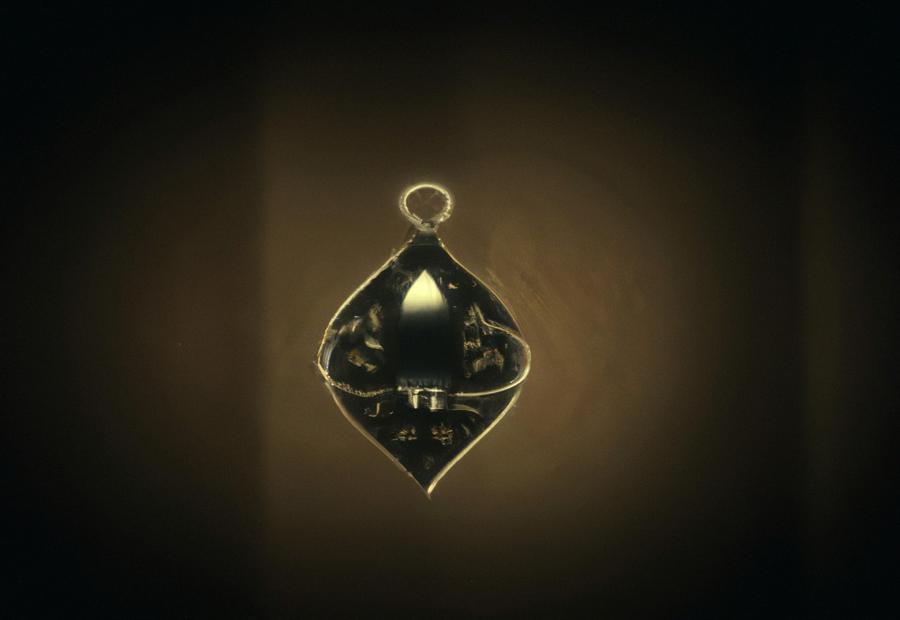
Photo Credits: Www.Blackdiamondpendant.Com by Stephen Torres
Black diamonds are becoming increasingly popular in jewelry, especially in pendants. However, it is important to note that there are different types of black diamonds. In this section, we’ll explore the three main types of black diamonds: natural, treated natural diamonds, and synthetic diamonds. Each type has its unique features, and we’ll uncover what sets them apart and how to authenticate them.
Natural black diamonds
Natural black diamonds are an eye-catching choice for jewelry lovers. They only consist of graphite and carbon. Plus, they have high levels of hydrogen and nitrogen, giving them their dark color. Their crystal structure makes them different from other types of carbon.
Those hunting for natural black diamond jewelry should watch out for imperfections. These highlight the desired “earthy” look of the pieces. It is a must to talk to a reliable jeweler before buying any diamond jewelry, like pendants with natural black diamonds. Reliable jewelers can do extra tests on the piece to guarantee its genuineness. If you doubt a particular source, it is best to avoid it.
Apart from understanding natural black diamonds, it’s also significant to know about other diamond types that could have been treated. Seeking the advice of a reliable jeweler before making a purchase is strongly advised.
Treated white diamonds
The aim of the treatment is to produce diamonds with vivid colors and fewer inclusions than natural black diamonds. However, these treated diamonds are altered versions of white diamonds, not natural black ones. As long as they are ethically sourced and marketed correctly, they can provide value. Their quality may vary depending on the treatment, but they usually have higher brilliance and reflectivity than natural black diamonds.
It is essential to check the diamond’s certification and characteristics before buying. Professional jewelers can help with choosing. With expert knowledge on the differences between natural black, lab-grown, and treated white diamonds, verifying the authenticity of a black diamond pendant becomes easier.
Lab-grown diamonds are becoming popular for sustainability and affordability reasons, instead of natural black diamonds. Treated white diamonds may also be a valuable option, provided that they are sourced ethically and advertised accurately. So, it is worth doing research and working with a reputable jeweler to get the best quality diamond for your money.
Lab-grown diamonds
Lab-grown diamonds, or synthetic diamonds, are becoming more and more popular. One great thing is they have the same chemical make-up as natural diamonds, but are made in a much shorter time. This means consumers don’t have to wait for nature to take its course.
Another plus is lab-grown diamonds are more affordable than natural ones. This is because they can be made in large numbers. Unlike natural diamonds, which often come from unethical mining, lab-grown diamonds are made in a controlled environment and don’t hurt the environment.
To make lab-grown diamonds, a small diamond seed is put in a growth chamber and the pressure and heat that’s needed to make a diamond naturally is replicated. This can take anywhere from weeks to months, depending on the size and quality of the diamond.
The demand for ethical products is growing, so is the production of lab-grown diamonds. They are a great option for those looking for genuine, high-quality diamonds that are both affordable and sustainable. From engagement rings to black diamond pendants, they are a great choice.
Identifying Real Black Diamonds

Photo Credits: Www.Blackdiamondpendant.Com by Charles Thompson
With the diamond market flooded with imitation diamonds, it can be difficult to distinguish a real black diamond pendant from a fake one. But fret not, as we provide you with the necessary information to correctly identify genuine black diamonds. This section will elaborate on identifying characteristics and explain what inclusions and imperfections to take note of. You’ll also learn how to use a 10x loupe to inspect the diamonds. Furthermore, we’ll discuss two tests – namely the window effect test and the carbide scriber blade test – which can be utilized to confirm the authenticity of your black diamond pendant.
Characteristics of real black diamonds
Black diamonds are famed for their glamour and chic. Thus, they are popular gems in the jewelry world. However, distinguishing real black diamonds from fakes can be tough. To identify the real thing, it is necessary to look for certain features exclusive to these gems.
Genuine black diamonds have an opaque black color that sets them apart. They also have an amorphous structure with no consistent crystalline makeup or direction. Plus, these diamonds are famously tough-to-damage. Real black diamonds can contain flaws, such as little cracks and lines, which can be seen under magnification and don’t affect the diamond’s strength.
Authentic black diamonds also have a unique surface texture that is oftentimes smoother than other stones. Scratches are highly rare due to their hardness. Identifying real black diamonds, however, is not easy, and further steps may be needed to confirm their authenticity.
One customer’s experience shows why it is important to seek professional help when investing in expensive real black diamond pendants. The gemologists discovered that the stone in the customer’s pendant was synthetic, not natural.
To sum up, with the correct understanding of the special characteristics of real black diamonds, it is achievable to spot the real thing in a marketplace full of counterfeits. It is noteworthy that discovering imperfections in genuine black diamonds is not bad- it is a sign of their authenticity.
Inclusions and imperfections in black diamonds
When it comes to black diamonds, they are the same as any other diamond. Inclusions and imperfections can affect their value and authenticity. Identifying these features is key when researching a black diamond pendant. Here are five common features to look for:
- Pinpoints: small white or grey dots that may be visible under magnification
- Feathers: internal cracks that look like feathers
- Cleavage: breaks or cracks on a flat plane
- Clouds: areas of disruption in diamond formation
- Striations: lines or grooves on the stone’s surface
A 10x loupe can show more info about inclusions and treatments. Not all diamonds with inclusions are low quality. It depends on their type and severity. Treatments can obscure imperfections, making it hard to know if it’s artificial.
When shopping for a black diamond pendant, it’s important to understand inclusions and imperfections. A jeweler can help with this process. Ancient Indian texts on gemology discussed flaws in precious stones. A scratched surface in a black diamond is a sign of authenticity.
Scratches and surface of black diamonds
Black diamonds are amazing and rare. Verify the pendant is real. To know if it is, look closely at its scratches and imperfections. Real black diamonds have small crystals on the surface. However, treatments or enhancements can change the texture. Natural diamonds have fewer scratches. Pits or cracks on the surface can be signs of authenticity. Buy only from a reputable source. Scratches under magnification could mean the diamond has been treated.
The public became aware of black diamonds in the 20th century. In Victorian England, they were used for mourning jewelry. Now, they are trendy with modern jewelry designers.
Using a 10x loupe to examine black diamonds
To make sure a black diamond pendant is authentic, use a 10x loupe. Its magnification lets you see the diamond’s finer details, which are too small to see without it. Here are 6 easy steps for using a 10x loupe to check black diamonds:
- Make sure the diamond is clean and dry.
- Hold the diamond between your thumb and finger.
- Put the diamond under bright light and focus the loupe on it.
- Look closely at each facet’s color and clarity.
- Check for any inclusions or blemishes.
- Compare it with other known natural black diamonds.
Knowledge is key when using a 10x loupe. You need to know what to look for. Inclusions or blemishes’ shape and placement can show if a diamond is authentic.
When using a 10x loupe, also examine the facets for patterns. Every natural diamond has its own unique crystal growth patterns. Compare different cuts and observe their symmetry too.
Using a 10x loupe to examine black diamonds is an important appraisal step. With practice and knowledge, anyone can become an expert.
Window effect and carbide scriber blade tests of black diamonds
Do you want to know if your black diamond is real? Then, use the Window effect and Carbide scriber blade tests.
For the Window effect, put the diamond on a white paper with dots or letters. Genuine diamonds will let light through, so their true black color will show. Fake ones will reflect their color onto the paper.
The Carbide scriber blade test requires a sharp tool to scratch the diamond’s surface. Real diamonds can only be scratched by another diamond. Artificial or treated diamonds will get scratched easily. This will also reveal any treatments done to make them look better.
These tests are great for verifying black diamond pendants. You can also ask jewelers for advice or perform the fog test. To avoid buying fake gemstones, buy from reliable sources and dealers who offer assurance about their products. Otherwise, you could waste a lot of money on fake pieces.
Simple Tests to Verify if a Black Diamond Pendant is Real
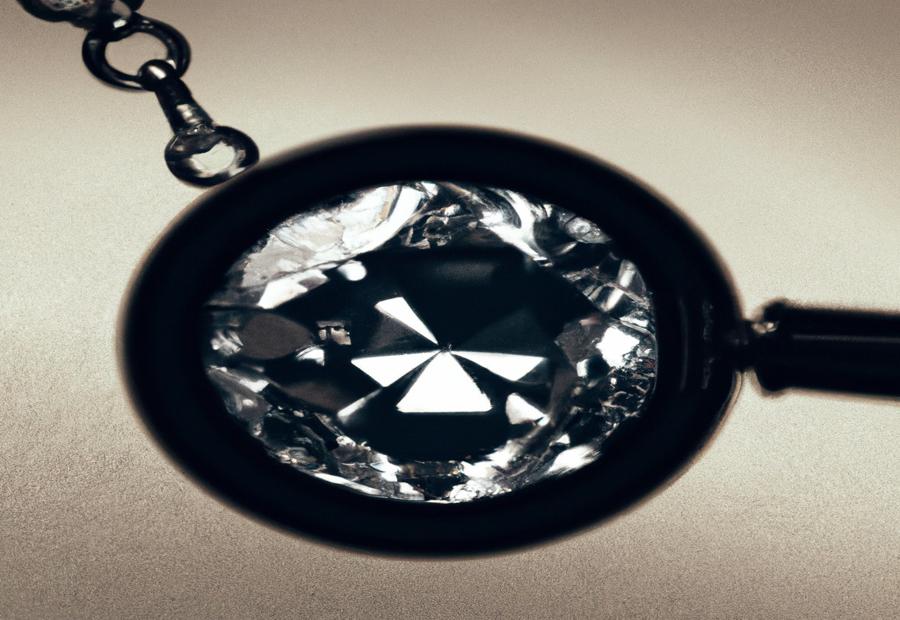
Photo Credits: Www.Blackdiamondpendant.Com by Carl Young
Black diamonds are often used to create stunning jewelry pieces due to their unique and captivating beauty. However, as their popularity continues to grow, the market has become inundated with imitation diamonds. In this section, we will explore some simple tests to help you determine if a black diamond pendant is authentic. Our first test, known as the fog test, can assist with determining the diamond’s authenticity.
Fog test
When it comes to verifying a black diamond pendant’s authenticity, the fog test can be done. This involves blowing hot air onto the diamond. Natural diamonds disperse heat quickly and synthetic ones take longer to clear the fog.
The fog test is often used by jewelers. But it’s not enough to ensure the diamond’s realness. It should be combined with other methods.
Seek out a reputable jeweler for guidance. They have experience in examining diamonds and can help you buy a genuine product.
One customer brought in their diamond pendant for examination. It turned out to be synthetic and treated to look like a black diamond. The customer was thankful for the honest assessment and returned with another piece that passed the tests.
Get advice from a reliable jeweler before buying a black diamond pendant.
Seeking Advice from a Reputable Jeweler

Photo Credits: Www.Blackdiamondpendant.Com by Zachary Roberts
If you’re in the market for a black diamond pendant, it’s important to know how to verify its authenticity. One way to do so is by checking if it has been certified by a reputable gemological laboratory such as the Gemological Institute of America (GIA) or the International Gemological Institute (IGI). In this section, we’ll explore the importance of purchasing a certified black diamond pendant and how seeking advice from a trusted jeweler can be a critical step in the process.
Importance of seeking advice from a reputable jeweler
Buying a black diamond pendant? Get advice from a reliable jeweler. They can tell you if it’s real, what quality, and how much it’s worth. They can guide you through the purchasing process – easy and stress-free.
Jewelers who have worked with diamonds know what to look for. They can tell if it’s natural or lab-created. Also, they know which suppliers to trust.
Don’t buy without consulting a jeweler. You could end up wasting your money on an inferior or fake product. A reputable jeweler will guarantee your money is well-spent. So it’s best to get advice beforehand.
Expert Ways to Verify the Authenticity of a Black Diamond Pendant
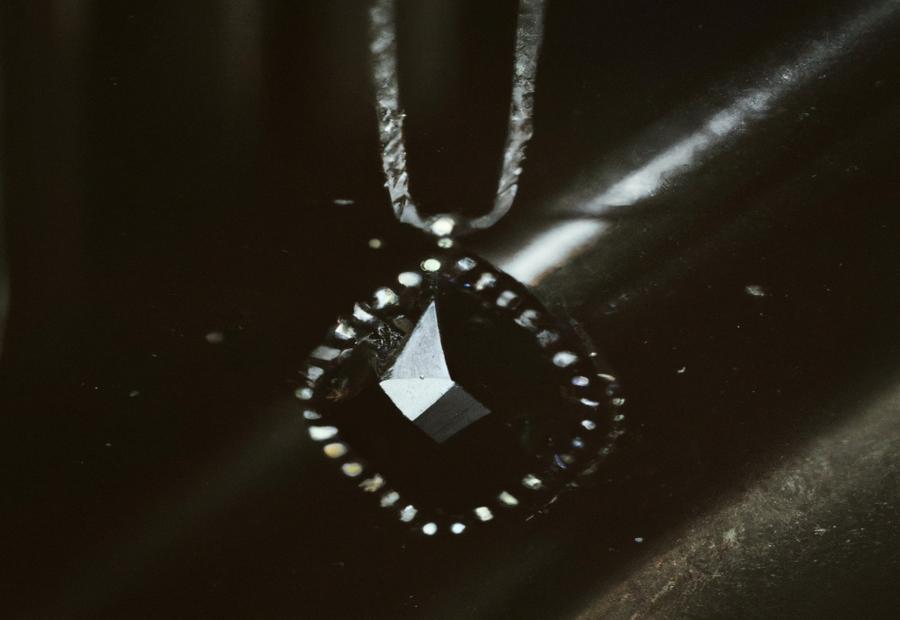
Photo Credits: Www.Blackdiamondpendant.Com by Paul Smith
If you’re planning to buy a black diamond pendant, it’s crucial to verify its authenticity. In this section, we’ll explore expert ways that can help you determine the diamond’s genuineness. We’ll look into conducting thermal conductivity tests and submerging the diamond in water, among other techniques, which have been found to be effective in determining the authenticity of a diamond.
Thermal conductivity test
The thermal conductivity test is an expert way to check the genuinity of a black diamond pendant. A special machine is used which measures how well a material conducts heat. Diamonds have great thermal conductivity, meaning they allow heat to pass through easily, unlike other materials.
A table can be made to show differences in thermal conductivity between diamonds and other materials. The table can include columns for:
| Material | Thermal Conductivity (W/mK) | Remarks |
|---|---|---|
| Glass | 1.05 (W/mK) | Low thermal conductivity compared to diamonds. |
| Cubic zirconia | 3.7 (W/mK) | Low thermal conductivity compared to diamonds. |
| Moissanite | 4.0- 6.0 (W/mK) | Low thermal conductivity compared to diamonds. |
| White Sapphire | 35 (W/mK) | Low thermal conductivity compared to diamonds. |
It’s important to note that this test works best with professional equipment operated by experienced jewelers or gemologists. At-home setups won’t give accurate results. Also, black diamonds usually have lower thermal conductivity levels than other diamond types due to their structure and chemical composition.
In conclusion, the thermal conductivity test is a useful way to spot a fake black diamond pendant. It should be used in combination with other tests and feedback from reliable sources before making a purchase.
Submerse in water to determine if it is a real diamond
Submerging a diamond in water is a way to check if it’s real. If you’re buying a black diamond, knowing it’s real is essential. The submersion method is a good way to see if a black diamond pendant is genuine. Here’s how to find out:
- Fill a glass with water – Fill it three-quarters full with tap water at room temp.
- Drop the pendant – Gently place it in the glass and watch what it does. Real diamonds sink right away since they’re dense.
- Check the light – See if light passes through it. If it distorts or goes at an angle, it’s likely fake.
This test isn’t always accurate since some diamonds have different densities. So, use it with other tests for accuracy. It’s easy, cheap, and you can do it at home. No special equipment needed.
Best Practices to Ensure You Buy a Real Diamond
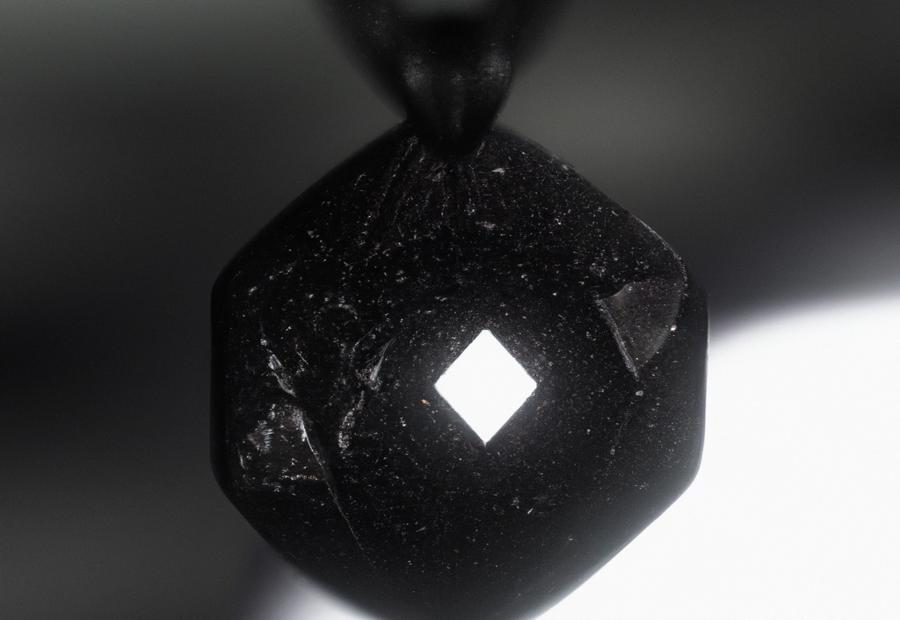
Photo Credits: Www.Blackdiamondpendant.Com by Dylan Sanchez
Do you ever wonder if your black diamond pendant is authentic? In this section, we will discuss the best practices for ensuring that your diamond purchase is legitimate and of high quality. It is important to buy from a credible source and to have a good understanding of what you are purchasing. By doing so, you can make an informed and confident purchase. Do not be left unsure about authenticity – read on to learn more.
Importance of buying from a reputable source
When buying a black diamond pendant, it’s essential to get it from a reputable source. This ensures the product is real and worth the money. Reputable sellers offer warranties, certificates of authenticity, and customer service.
But buying from unreliable sources can be risky. They may misrepresent their products, claiming they’re natural or high quality, when they’re actually treated or lab-grown diamonds. Supporting such sellers encourages unethical practices and can reduce the quality of the jewelry.
So, it’s important to research certified jewelers or well-known brands when buying a black diamond pendant. They should provide information on origin, quality ratings, and treatments (if any). Reputable sellers should also allow buyers to get certifications from third-party agencies to prove authenticity. By buying from trustworthy sources, buyers can be sure their investment is worthwhile and ethical.
Know what you are buying
When it comes to black diamonds, there are two main types: natural and treated. Natural diamonds are rare and valuable. Treated black diamonds are actually white ones that have been altered. It is important to know this difference when looking to purchase a pendant.
Seeking advice from a reputable jeweler can help. They can explain the types of black diamonds and guide you in buying the right one. An expert can give you a better understanding of what to look for when purchasing.
To confirm authenticity, several tests can be done. These include the thermal conductivity test and a fog test. Knowing how to perform these tests can help identify real black diamonds and avoid getting a fake one.
It is essential to be informed when buying a black diamond pendant. This knowledge can help make an informed decision and protect your investment.
Conclusion
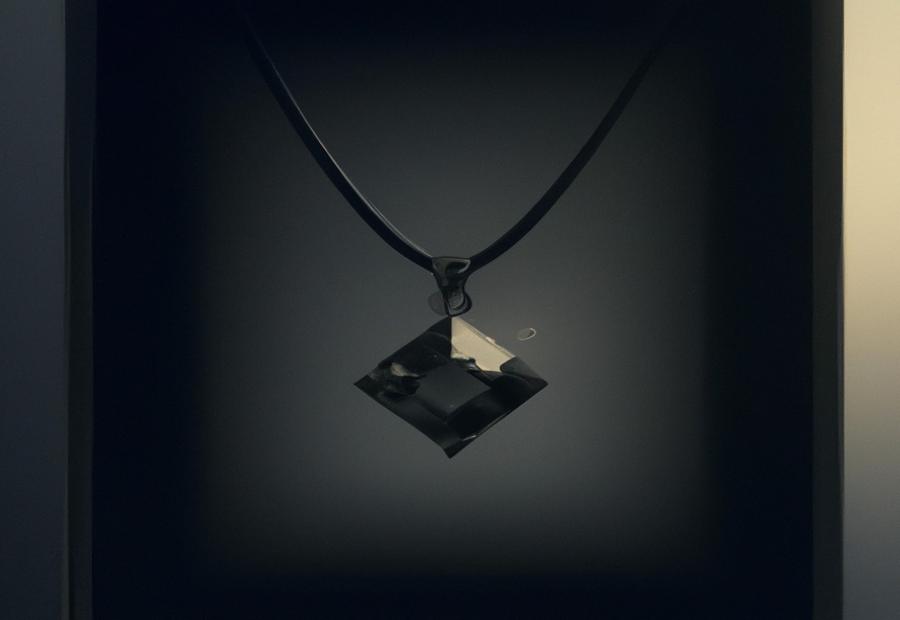
Photo Credits: Www.Blackdiamondpendant.Com by Willie White
Verifying authenticity of a black diamond pendant is key. To get your money’s worth, be meticulous and check its color, cut, clarity, and carat weight. Request certifications from reputed organizations like GIA or AGS. This’ll prove the diamond’s quality and origin. Get help from a certified gemologist. They’ll provide assurance and an appraisal report to outline the diamond’s value. With these tips, customers can buy a genuine black diamond pendant with confidence.
Five Facts About Verifying the Authenticity of a Black Diamond Pendant:
- ✅ Black diamonds are rare and can only be found in select locations such as Brazil and the Central African Republic. (Source: Itshot.com)
- ✅ There are three types of black diamonds: natural, treated white diamonds, and lab-grown diamonds. (Source: https://www.astteria.com/blog/how-to-identify-a-black-diamond/)
- ✅ A real black diamond will have nicks and scratches on its surface, and a smooth surface indicates it is not genuine. (Source: https://www.gemonediamond.com/identify-black-diamonds/)
- ✅ The window effect of diamonds can give insight into their validity. (Source: https://www.gemonediamond.com/identify-black-diamonds/)
- ✅ It is important to consult with a reputable jeweler to verify the authenticity of a black diamond pendant. (Source: https://lexiejordanjewelry.com/blogs/posts/how-to-tell-if-a-diamond-is-real)
FAQs about How To Verify The Authenticity Of A Black Diamond Pendant?
How to Determine if a Diamond is Real?
Buying a diamond is an emotional purchase, and it’s important to know if it’s real or not before committing to it. There are many “fake” diamond counterparts that can be mistaken for a real diamond, such as white topaz, white sapphire, and white zircon. To avoid being deceived or misled into buying a lower-quality stone or a different gemstone, it’s best to do your homework first and know the difference between mounted and loose diamonds. Seeking advice from a reputable jeweler is recommended if you’re questioning the authenticity of a diamond ring.
How to Identify a Black Diamond?
Black diamonds are becoming increasingly popular in the jewelry industry due to their unique beauty. There are three types of black diamonds: natural, treated white diamonds, and lab-grown diamonds. Natural black diamonds can only be found in the Central African Republic and Brazil regions. Black diamonds can be identified by their inclusions or imperfections in the structure, which can be used to distinguish them from other black gemstones. A true black diamond will also have nicks and scratches on its surface, unlike an imitation stone. However, it’s best to consult with a diamond expert with proper experience and equipment to confirm the diamond is genuine.
How to Test if a Diamond is Real?
To make sure a diamond is real, there are simple tests that can be done at home, such as the fog test. The fog test is a quick and easy way to determine if a diamond is real or not. If it clears up after a second or two, it’s real, but if it stays fogged for three seconds or more, it’s fake. However, no single at-home test should be regarded as conclusive, and a diamond expert with proper experience and equipment is needed to confirm if a diamond is real or fake.
Important Facts about Black Diamonds:
Black diamonds are rare and can only be found in select locations such as Brazil and the Central African Republic. They are primarily used for industrial cutting but are also becoming popular in jewelry. Historically, black diamond jewelry was rare due to superstitions that they were cursed. Black diamonds are real diamonds that are black in color. To distinguish black diamonds from other black gemstones, there are different methods to test its authenticity. Black diamonds can be identified by their inclusions or imperfections in the structure. A 10x loupe can be used to examine the diamond on a microscopic level. The window effect of diamonds can also give insight into their validity. A carbide scriber blade can be used to test the diamond’s surface, and an authentic diamond will not be affected by scratches due to its hardness.

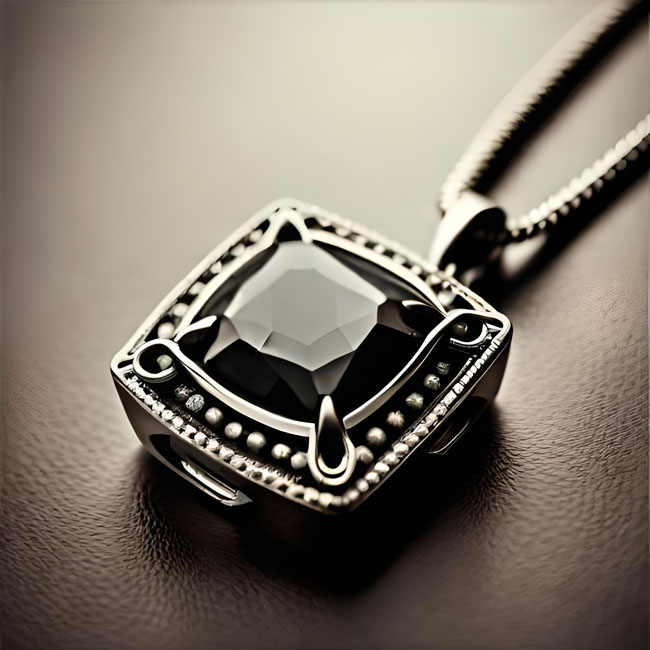

Leave a Reply